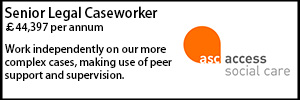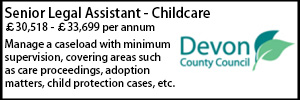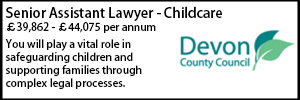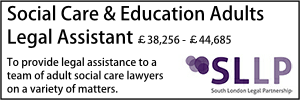DHSC care home visiting guidance
- Details
The Department for Health and Social Care has published its eagerly awaited care home visiting guidance for England. Alex Ruck Keene sets out the key points.
The guidance, Visiting arrangements in care homes for the period of national restrictions, was published on 5 November 2020. It emphasises that:
Receiving visitors is an important part of care home life. Maintaining some opportunities for visiting to take place is critical for supporting the health and wellbeing of residents and their relationships with friends and family.
And that:
Each care home is unique in its physical layout, surrounding environment and facilities. Residents vary in their needs, health and current wellbeing. Providers are best placed to decide how to deliver visits in their own setting in a way that meets the needs of their residents individually and collectively. The individual resident, their views, their needs and wellbeing are an important focus of decisions around visiting.
For providers and Directors of Public Health, the guidance provides that:
The first priority is making sure those in care homes receive the care and support they need. That includes making sure that residents are not put at avoidable risk of contracting COVID-19, which can have such a devastating impact if it spreads through a care home, infecting vulnerable residents and potentially care staff.
It reminds readers that Directors of Public Health have the powers to issue directions to homes to close to visiting: i.e. to make visiting actively unlawful (as opposed to contrary to any guidance), and that:
In the event of an outbreak in a care home, the home should rapidly move to stop visiting (except in exceptional circumstances such as end of life) to protect vulnerable residents, staff and visitors. There may be local policy and outbreak management arrangements, which will be important to follow. These restrictions may continue until such time as it is understood that the outbreak has been brought under control and the care home has recovered – at this point visiting may be restarted but with the usual infection prevention and control measures and any enhancements required due to any risks identified following the recent outbreak.
It is important to note that, unless a Director of Public Health has directed a home to close to visiting, and as noted here, visits by families and friends to those in care homes are entirely lawful under the November 5 lockdown regulations. This means that any decision by a care home to stop visiting which is not taken following a direction to close to visiting must be (1) based upon evidence; (2) not framed so as to make it sound as if visiting would be against the law; and (3) not taken on a blanket basis (the ADASS Advice Note on Infection Control, Essential Visiting and Human Rights in Care Homes published on 2 November also reiterates the legal unacceptability of blanket bans).
The advice for providers in establishing their visiting policies is that:
Providers should work collaboratively with residents, families and local social care and health professionals to strike a good balance between the benefits of visiting for residents’ health and wellbeing and quality of life; and the infection risks that arise from increased interactions of visitors, residents and staff in the facilitation of visiting.
In developing their risk assessments, the guidance identifies a number of factors that the providers should take into account, including, importantly:
the health and wellbeing risks arising from the needs of the cohort of residents in that setting – this should include both whether their residents’ needs make them particularly clinically vulnerable to COVID-19 and whether their residents’ needs make visits particularly important (for example, people with dementia, a learning disability or autistic people may be permitted visitors when restricting visitors could cause some of the residents to be distressed). Social workers can assist with individual risk assessments, for visits, and can advise on decision-making where the person in question lacks capacity to make the decision themselves. This should include an individualised risk assessment to assess the rights and needs of individual residents as well as any specific vulnerabilities outlined in their care plan and the role that visiting can play in this. In making these decisions, the care provider should actively involve the resident, their relatives or friends, any advocates, commissioners and appropriate members of the multi-disciplinary team and where appropriate volunteers.
The guidance sets out a series of principles providers should ensure are met in the arrangements and conduct of individual visits, including that:
visitor numbers should be limited to a single constant visitor wherever possible, with an absolute maximum of 2 constant visitors per resident. This, for example, means the same family member visiting each time to limit the number of different individuals coming into contact. This is in order to limit the overall number of visitors to the care home and/or to the individual, and the consequent risk of disease transmission from multiple different routes.
In a more developed fashion to the previous guidance, the November 5 iteration sets out potential practical arrangements for visits, both inside the care home and wherever possible, outside in the open air.
The guidance also sets out how providers should make visiting decisions for specific residents or groups of residents where their particular needs make COVID-19 secure visits “challenging.” Importantly, in this, the additional factors (over and above any general visiting policy) include as the first two bullet points:
- the benefits to a person’s wellbeing by having a particular visitor or visitors
- the extent of the harm that will be experienced by the resident from a lack of visitation or whether the individual is at the end of their life.
As regards those with impaired decision-making capacity, the guidance notes that:
Providers must consider the rights of residents who may lack the relevant mental capacity needed to make particular decisions and, where appropriate, their advocates or those with power of attorney should be consulted. For example, some people with dementia and learning disabilities may lack the relevant capacity to decide whether or not to consent to a provider’s visiting policy. These residents will fall under the empowering framework of the Mental Capacity Act 2005 (MCA) and are protected by its safeguards.
The guidance also addresses infection control and communicating with families and visitors.
The obvious risk of having more developed principles as set out in this guidance, building on the earlier iteration, is that providers will feel that the risk assessment process that they have to undertake leads them to the conclusion that they can only facilitate visits in more restrictive circumstances. It is, however, important that the guidance reiterates in several places the need to understand the risks to the individuals concerned of not having visits, and of the need to respond to those for whom COVID-19 secure visits are more complex.
The press release trailing the guidance also promised more concrete steps actively to support the ability of family and friends to visit, as well as to address the potential problems of infection being spread by professionals attending multiple homes:
Plans are currently being developed to allow specific family and friends to visit care homes supported by testing. A sector-led group is overseeing the development of these plans with trials set to begin later this month.
A new national programme for weekly testing of professionals who regularly visit care homes, including community nurses and physiotherapists, will also be rolled out in the coming weeks following a successful pilot in Cambridgeshire, Peterborough and Northamptonshire.
Alex Ruck Keene is a barrister at 39 Essex Chambers. This article first appeared on his Mental Capacity Law and Policy blog.























































